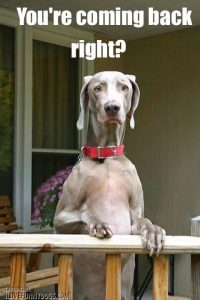Originally published November 14th, 2014
 Your dog adores you. She follows you around and wants to be near you all the time. And that’s wonderful – until you must go away. Then your dog howls or barks or chews on things until you return. This is called separation anxiety. Unless you can stay home 24/7 or take the dog with you everywhere you go, you must deal with this issue (or replace a lot of shoes and furniture and endure the wrath of neighbors). To make things worse, sometimes this condition is your fault. I know: I’m guilty too.
Your dog adores you. She follows you around and wants to be near you all the time. And that’s wonderful – until you must go away. Then your dog howls or barks or chews on things until you return. This is called separation anxiety. Unless you can stay home 24/7 or take the dog with you everywhere you go, you must deal with this issue (or replace a lot of shoes and furniture and endure the wrath of neighbors). To make things worse, sometimes this condition is your fault. I know: I’m guilty too.
I was getting ready to go out in the yard and do some work. Marie was resting on the sofa. I informed Marie I was going outside and asked if she needed anything before I left. She said, “Just take Blondie with you: she goes spastic every time you leave the house.”
Blondie has a mild separation anxiety issue. When I leave, she paces through the house peering out all the windows to see where I’ve gone.
Blondie is needy. She spent most of her life in an extremely neglectful situation and was totally withdrawn when she was rescued. We fostered her and helped her come out of her shell. We fell in love with the affectionate, silly girl she became and adopted her. Gun fire and thunder make her very nervous and she comes to me for comforting. I stroke her head to ease her anxiety. That’s the wrong thing to do, but I’ve done it.
We spend all of almost every day together. Blondie follows me around like a golden shadow. Sometimes she comes and asks for skritchies, and I’ll give them for a short time. She is accustomed to my being here, when I leave she gets anxious. But she’s a good girl: never misbehaves, she just runs around looking for me. I’m lucky: many people have dogs that do bad things when they are left alone. If yours is one of them, here’s what this is and how to deal with it.
What is Separation Anxiety?
Dogs with separation anxiety exhibit distress in the form of behavior problems when left alone. Typically, they’ll have a dramatic anxiety response within a short time after their owners leave them. Common distress symptoms include one or more of the following: scratching and digging near doors and windows in an attempt to escape and find their people, chewing door frames or other items in an attempt to channel their anxiety, barking, whining and howling in an attempt to summon their person, excessive salivation, chewing on or licking themselves, and sometimes even urination and defecation due to the immense physiological effect of prolonged stress.
What Causes Separation Anxiety?
Separation anxiety can develop in dogs who have been abandoned at key points in their psychological development. Perhaps they were removed from mother and littermates too early (prior to 8 weeks of age) or too late (after 14 weeks). Perhaps they were not properly integrated into their first home and got relegated to a basement, garage or yard. Perhaps they endured a traumatic event, such as a frightening experience at a shelter or kennel, or a significant change in their household, such as a new person joining the family, a move to another house, or change in the owner’s work schedule.
Some dogs tend to become extremely attached to their new person, and then insecure when that person leaves.
Another cause is when a person fawns over a dog: petting and touching her excessively so that she comes to expect, even demand this attention.
How to Deal with Separation Anxiety
Depending on the severity of the problem, there are several steps an owner can take to reduce or eliminate the problem.
Do Not Punish the Dog: it doesn’t Work
Separation anxiety is a panic response, not behavior that the dog willfully engages in. Punishment: yelling and ostracizing, will not work to cure separation anxiety; it will only aggravate the situation. Punishment raises the dog’s overall anxiety and compounds it with fear of her owner.
Remember that if you are stressed out, your mood will only add to your dog’s anxiety. Stay calm and unemotional when dealing with bouts of separation anxiety.
Avoid Excessive Petting
Make an effort not to handle or pet your dog every time you encounter her. Be especially mindful of not responding immediately when the dog demands attention from you. Blondie often trots over when I sit in a chair and thumps my hand with her nose, “Skritchies, please.” If I give in (and too often I do) it reinforces in her mind that I am at her beck and call, and should be available any time she wants me. If I delay: tell her to sit or shake, then give the skritchies as a reward for her good behavior I can turn the situation around. She’s obeying me, not I her.
Practice Leaving
If your dog’s separation anxiety is severe, it helps to desensitize her by leaving the house for short periods and coming right back. Make the absences a little longer over time, returning just as she shows signs of anxious behavior. Be careful, however, not to reward barking or howling by returning.
Don’t Make a Fuss
When you leave, do NOT make a fuss over the dog with a long, drawn-out goodbye scene. It is a good idea to come up with a key phrase that you use consistently to let the dog know you are leaving but you will be back: “You’re in charge”, or “I’ll see you later”, something like that.
You may want to give a treat or a safe chew toy that will distract her while you exit the home.
Also do not overdo the attention when you return. Delay that until a few minutes after you’ve entered. Tell her to sit, then look through your mail or check your phone messages. Then give her a good greeting and love up on her. By separating the love-fest from your entry you reduce the anxiety and expectation when you come in.
Don’t Expect too Much
Don’t leave the dog for longer that she can comfortably hold urine and bowels. This stress just adds to the anxiety of missing you. If you must be away all day and she cannot hold it that long, arrange for a neighbor or a sitter to come by and let her out to relieve herself or set up a training pad in a corner of her containment area and train her to use that.
Exercise First
It often helps to take your dog out for a vigorous walk or play time just before you must leave. Wearing her out will help her settle in as you go, and she may well sleep a bit rather and obsess over your departure.
Summary
We want our pet to be loving and companionable, but allowing her to fixate and become anxious when we are separated is not good for the dog or for you (or your home). Alleviating separation anxiety will improve the quality of life for the both of you. If the anxiety is severe, it will take some time, working in small steps, but it will be time well spent.
Resources:
- paw-rescue.org
- The Dog Behavior Answer Book, by Arden Moore
| If you enjoy our updates, Doggy Tales, and educational articles consider subscribing for notices when new pieces are posted. It’s painless and you can unsubscribe any time you want. Your e-mail address is used ONLY to deliver these notices. | [email-subscribers namefield=”YES” desc=”” group=”Public”] |



